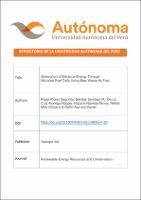| dc.contributor.author | Rojas-Flores, Segundo | |
| dc.contributor.author | Benites, Santiago M. | |
| dc.contributor.author | De La Cruz-Noriega, Magaly | |
| dc.contributor.author | Nazario-Naveda, Renny | |
| dc.contributor.author | Otiniano, Nélida Milly | |
| dc.contributor.author | Delfín-Narciso, Daniel | |
| dc.date.accessioned | 2024-11-14T20:39:09Z | |
| dc.date.available | 2024-11-14T20:39:09Z | |
| dc.date.issued | 2023 | |
| dc.identifier.uri | https://hdl.handle.net/20.500.13067/3492 | |
| dc.description.abstract | The lack of electricity in places far from the big cities, plus the lack of efficient collection of organic waste, has generated two environmental problems that are accentuated in developing countries, mainly because remote places still use firewood or tree residues for cooking or giving light at night, while the absence of inefficient collection of waste, mainly vegetables, in city markets causes merchants to throw their waste around these markets, attracting bad odors, diseases, and rodents. One of the wastes with the largest amount is beets or beets, which, due to their decomposition, spoil quickly compared to other vegetables. For this reason, this research has as its main objective the generation of bioelectricity through microbial fuel cells (MFCs) with a single chamber using beet waste as fuel on a laboratory scale. Thus, 100 mL of beet waste extract was also used in each MFCs (they were carried out in triplicate). It was possible to generate peak electrical current and voltage of 5.64 ± 0.75 mA and 1.03 ± 0.25 V, whose substrate had an electrical conductivity of 175.71 ± 6.87 mS/cm with an optimum operating pH of 4.86 ± 0.34. While the internal resistance was calculated using Ohm’s Law, yielding a value of 48,253 ± 4749 Ω, also showing a maximum power density of 96,741 ± 4874 mw/m2 at a current density of 5614 mA/m2. The three MFCs-SC were seriously connected to observe their potential for the generation of bioelectricity, managing to turn on a led bulb (RED) for 6 days. | es_PE |
| dc.format | application/pdf | es_PE |
| dc.language.iso | eng | es_PE |
| dc.publisher | Springer Link | es_PE |
| dc.rights | info:eu-repo/semantics/restrictedAccess | es_PE |
| dc.rights.uri | https://creativecommons.org/licenses/by-nc-nd/4.0/ | es_PE |
| dc.source | AUTONOMA | es_PE |
| dc.subject | Beet Waste | es_PE |
| dc.subject | Microbial Fuel Cells (MFCs) | es_PE |
| dc.subject | Waste-to-Energy | es_PE |
| dc.subject | Renewable Energy | es_PE |
| dc.title | Generation of Electrical Energy Through Microbial Fuel Cells Using Beet Waste As Fuel | es_PE |
| dc.type | info:eu-repo/semantics/article | es_PE |
| dc.identifier.journal | Renewable Energy Resources and Conservation | es_PE |
| dc.identifier.doi | https://doi.org/10.1007/978-3-031-59005-4_20 | es_PE |
| dc.subject.ocde | https://purl.org/pe-repo/ocde/ford#2.07.00 | es_PE |
| dc.source.beginpage | 175 | es_PE |
| dc.source.endpage | 181 | es_PE |


